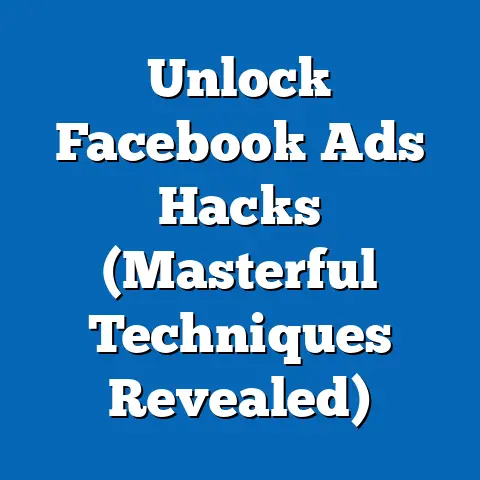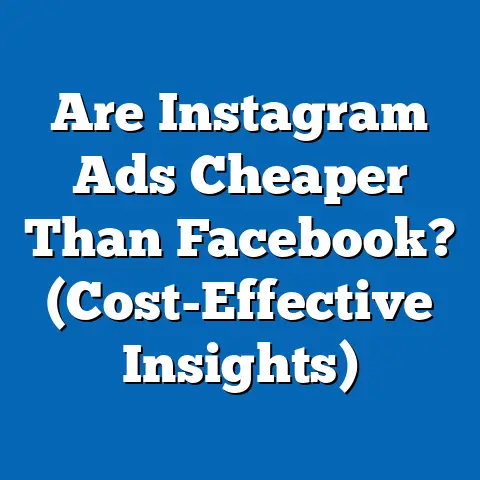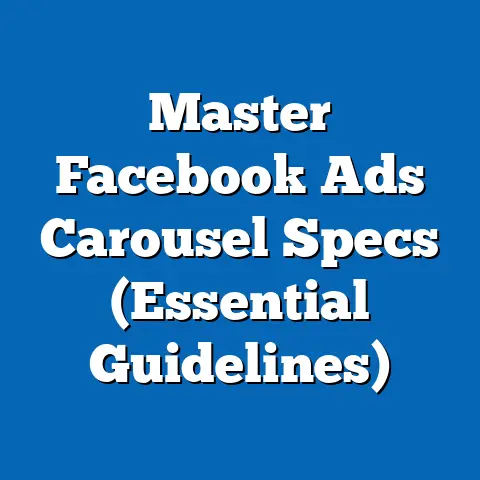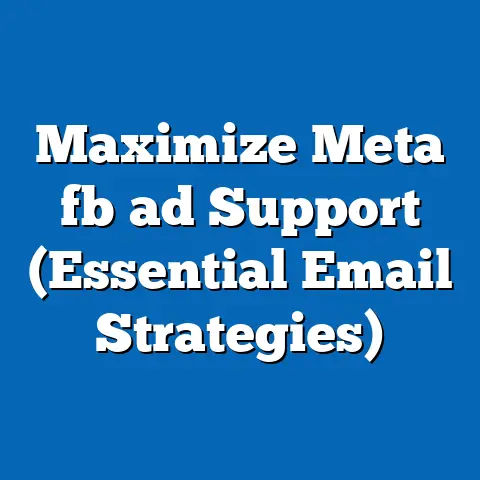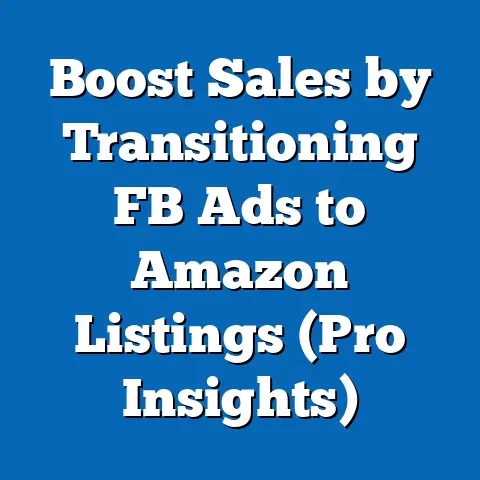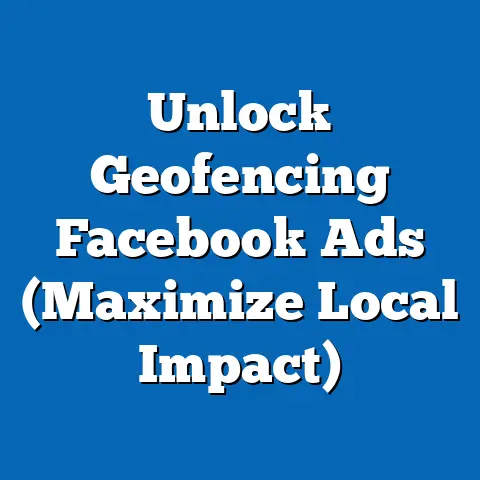Edit Facebook Ad Effortlessly (Expert Tips Inside)
Imagine scrolling through your Facebook feed and suddenly being greeted by a vibrant explosion of color – a brilliantly designed ad featuring a mouthwatering pizza from a local Italian restaurant. The image is crisp, the copy is witty and inviting, and the call-to-action beckons you to “Order Now for 20% Off!” It’s an ad that stops you in your tracks and makes you seriously consider dinner. But what if that ad initially had a blurry image, a confusing message, and no clear call-to-action? The difference between a conversion and a scroll-past often lies in the editing.
This article will equip you with the knowledge and tools you need to transform your ads from mediocre to magnetic. I’ll delve into the essential components of a Facebook ad, explore the various tools available for editing, share expert tips for crafting compelling content, highlight common mistakes to avoid, and even showcase real-life case studies to inspire your own creative endeavors.
My Thesis: By understanding the core elements of a Facebook ad, leveraging available editing tools, implementing expert copywriting and visual techniques, avoiding common pitfalls, and drawing inspiration from successful campaigns, you can significantly improve the performance of your Facebook ads and achieve your marketing goals.
Understanding Facebook Ad Basics
Before diving into the nitty-gritty of editing, it’s crucial to have a solid grasp of the fundamental components that make up a Facebook ad. Think of it like understanding the ingredients before you start cooking.
Components of a Facebook Ad
A Facebook ad is a carefully crafted combination of several key elements, each playing a vital role in capturing attention and driving action:
- Visuals (Image or Video): This is the first thing people see. It needs to be eye-catching, relevant, and high-quality.
- Headline: The headline is a short, attention-grabbing line of text that appears below the visual. It should clearly communicate the ad’s main message.
- Ad Copy (Body Text): This is the longer text that provides more detail about the product or service being advertised. It should be concise, persuasive, and highlight the benefits for the user.
- Call-to-Action (CTA) Button: This is the button that prompts users to take a specific action, such as “Shop Now,” “Learn More,” or “Sign Up.” A clear and compelling CTA is essential for driving conversions.
- Audience Targeting: This refers to the specific demographics, interests, and behaviors of the people you want to see your ad. Effective targeting ensures that your ad reaches the right audience.
Importance of Editing
Why is editing so important? Because even the smallest changes can have a significant impact on your ad’s performance. Think of it like fine-tuning a musical instrument. A slight adjustment to a string can make a world of difference in the sound it produces.
- Improved Relevance: Editing allows you to tailor your ad to better resonate with your target audience. By refining your messaging and visuals, you can increase the ad’s relevance and make it more appealing to potential customers.
- Increased Engagement: A well-edited ad is more likely to capture attention and encourage interaction. By optimizing your headline, ad copy, and visuals, you can boost engagement metrics such as likes, comments, and shares.
- Higher Conversion Rates: Ultimately, the goal of most Facebook ads is to drive conversions, whether it’s website visits, lead generation, or sales. By editing your ads to improve their clarity, persuasiveness, and relevance, you can significantly increase your conversion rates.
- Reduced Ad Costs: Believe it or not, effective editing can also help you reduce your ad costs. When your ads are more relevant and engaging, Facebook rewards you with lower costs per click and higher ad rankings.
Takeaway: Understanding the basic components of a Facebook ad and recognizing the importance of editing are the first steps towards creating high-performing campaigns.
Tools for Effortless Editing
Fortunately, you don’t have to be a graphic design wizard or a copywriting genius to effectively edit your Facebook ads. There are a plethora of tools available to streamline the process and make it more accessible for everyone. I’ve found that combining Facebook’s native tools with some helpful third-party applications provides the best results.
In-built Facebook Tools
Facebook Ads Manager itself offers a range of editing features that are essential for optimizing your campaigns:
- A/B Testing (Split Testing): This allows you to test different versions of your ad against each other to see which performs best. You can test different headlines, visuals, ad copy, CTAs, and even audience targeting options. I regularly use A/B testing to experiment with different ad variations and identify the most effective combinations.
- Ad Previews: Before launching your ad, you can use the ad preview tool to see how it will look on different devices and placements. This is crucial for ensuring that your ad is mobile-optimized and visually appealing across all platforms.
- Ad Reporting: Facebook Ads Manager provides detailed reporting on your ad performance, including metrics such as reach, impressions, clicks, conversions, and cost per result. Analyzing this data is essential for identifying areas for improvement and making informed editing decisions. I always pay close attention to the click-through rate (CTR) and conversion rate to gauge the effectiveness of my ads.
- Creative Hub: The Creative Hub is a tool within Facebook that allows you to mock up and preview your ads before they go live. It’s a great way to experiment with different creative concepts and get feedback from your team.
Third-Party Tools
In addition to Facebook’s in-built tools, there are many third-party applications that can enhance your editing process:
- Canva: This is a popular graphic design tool that makes it easy to create visually appealing images and videos for your ads. It offers a wide range of templates, graphics, and fonts, even on the free plan, making it accessible to users of all skill levels. I often use Canva to create eye-catching visuals for my clients’ Facebook ads.
- Grammarly: This is a grammar and spell-checking tool that can help you polish your ad copy and ensure that it’s free of errors. It can also provide suggestions for improving your writing style and clarity. I find Grammarly particularly helpful for catching those pesky typos that can easily slip through the cracks.
- Headline Analyzer Tools (e.g., CoSchedule Headline Analyzer): These tools analyze the effectiveness of your headlines based on factors such as word balance, sentiment, and character count. They can provide valuable insights for crafting headlines that grab attention and drive clicks.
- Pexels/Unsplash: These are free stock photo websites that offer a wide selection of high-quality images you can use in your ads. Using professional-looking visuals is crucial for creating a positive impression and building trust with your audience.
Automation Options
Automation can be a game-changer when it comes to streamlining your Facebook ad editing process. Here are a few automation tools and techniques to consider:
- Automated Rules: Facebook allows you to set up automated rules that trigger specific actions based on certain performance criteria. For example, you can create a rule that automatically pauses an ad if its cost per result exceeds a certain threshold.
- Dynamic Creative Optimization: This feature allows Facebook to automatically test different combinations of your ad creative elements (e.g., headlines, visuals, ad copy) to identify the most effective combinations.
- Third-Party Automation Tools (e.g., Revealbot, AdEspresso): These tools offer advanced automation features such as rule-based optimization, budget allocation, and performance reporting.
Takeaway: By leveraging the right combination of in-built Facebook tools, third-party applications, and automation options, you can significantly streamline your ad editing process and improve the performance of your campaigns.
Expert Tips for Crafting Compelling Ads
Now that you have the tools at your disposal, it’s time to dive into the expert tips for crafting compelling ads that capture attention, drive engagement, and generate results.
Visual Appeal
The visuals are the first thing people see, so it’s crucial to make a strong impression. Here are a few tips for selecting eye-catching images and videos:
- Use High-Quality Images and Videos: Avoid blurry, pixelated, or low-resolution visuals. Invest in professional-quality images or videos that showcase your product or service in the best possible light.
- Choose Relevant Visuals: Make sure your visuals are directly relevant to your ad’s message and target audience. For example, if you’re advertising a fitness program, use images or videos of people working out and achieving their fitness goals.
- Use Color Psychology: Colors can evoke different emotions and associations. Consider using color psychology to your advantage when selecting visuals for your ads. For example, blue can convey trust and reliability, while red can convey excitement and urgency.
- Experiment with Different Visual Formats: Facebook offers a variety of visual formats, including single images, videos, carousels, and slideshows. Experiment with different formats to see which performs best for your target audience.
- Keep it Fresh: Rotate your visuals regularly to prevent ad fatigue. People are more likely to ignore ads they’ve seen repeatedly.
Copywriting Techniques
The ad copy is your opportunity to tell a story, highlight the benefits of your product or service, and persuade people to take action. Here are a few copywriting techniques to keep in mind:
- Write Strong Headlines: Your headline is the first thing people read, so it needs to be attention-grabbing and clearly communicate the ad’s main message. Use strong verbs, numbers, and emotional language to make your headlines more compelling.
- Use Storytelling: People are naturally drawn to stories. Consider using storytelling in your ad copy to connect with your audience on an emotional level and make your message more memorable.
- Highlight Benefits, Not Just Features: Focus on the benefits that your product or service provides, rather than just listing its features. Explain how your product or service can solve a problem, improve their lives, or make them happier.
- Use Clear and Concise Language: Avoid jargon, technical terms, and overly complex sentences. Use clear and concise language that is easy for your target audience to understand.
- Include a Strong Call-to-Action: Your call-to-action (CTA) should be clear, concise, and compelling. Tell people exactly what you want them to do, whether it’s “Shop Now,” “Learn More,” or “Sign Up.”
Audience Targeting
Effective audience targeting is essential for ensuring that your ads reach the right people. Here are a few tips for editing your ad settings to effectively reach your desired audience:
- Define Your Target Audience: Before you start creating your ad, take the time to clearly define your target audience. Consider factors such as demographics (age, gender, location), interests, behaviors, and income level.
- Use Facebook’s Targeting Options: Facebook offers a wide range of targeting options, including demographic targeting, interest-based targeting, behavior-based targeting, and custom audiences. Experiment with different targeting options to see which performs best for your ads.
- Create Custom Audiences: Custom audiences allow you to target people who have already interacted with your business, such as website visitors, email subscribers, or Facebook page fans. This can be a highly effective way to reach people who are already familiar with your brand.
- Use Lookalike Audiences: Lookalike audiences allow you to target people who are similar to your existing customers or website visitors. This can be a great way to expand your reach and find new customers who are likely to be interested in your product or service.
- Monitor Your Audience Targeting: Regularly monitor your audience targeting to ensure that you’re reaching the right people. Pay attention to metrics such as reach, impressions, and click-through rate to gauge the effectiveness of your targeting.
Testing and Iteration
The key to creating high-performing Facebook ads is continuous testing and iteration. Here are a few insights on the importance of testing different versions of your ads and analyzing results for continual improvement:
- A/B Test Everything: Don’t be afraid to experiment with different headlines, visuals, ad copy, CTAs, and audience targeting options. A/B test everything to see what works best for your target audience.
- Track Your Results: Use Facebook Ads Manager to track your ad performance and identify areas for improvement. Pay attention to metrics such as reach, impressions, clicks, conversions, and cost per result.
- Analyze Your Data: Regularly analyze your data to identify patterns and trends. What headlines are generating the most clicks? What visuals are driving the most engagement? What audience targeting options are resulting in the highest conversion rates?
- Iterate Based on Your Findings: Use your findings to make informed editing decisions. Refine your headlines, visuals, ad copy, CTAs, and audience targeting options based on what you’ve learned from your testing and analysis.
- Stay Up-to-Date: Facebook’s advertising platform is constantly evolving, so it’s important to stay up-to-date on the latest features, best practices, and industry trends.
Takeaway: Crafting compelling Facebook ads requires a combination of visual appeal, persuasive copywriting, effective audience targeting, and continuous testing and iteration.
Common Mistakes to Avoid
Even with the best tools and techniques, it’s easy to make mistakes when editing your Facebook ads. Here are a few common pitfalls to avoid:
Overloading with Information
One of the most common mistakes is trying to cram too much information into your ads. Remember, people have short attention spans, so it’s important to keep your ads concise and focused.
- Avoid Cluttering Your Ads with Too Much Text: Use clear and concise language that is easy for your target audience to understand.
- Limit the Number of Visuals: Don’t overload your ads with too many images or videos. Choose one or two high-quality visuals that effectively communicate your message.
- Focus on the Most Important Information: Highlight the key benefits of your product or service and make it clear what you want people to do.
Ignoring Mobile Optimization
In today’s mobile-first world, it’s crucial to ensure that your ads are optimized for mobile devices.
- Use Mobile-Friendly Visuals: Choose visuals that look good on small screens. Avoid images with small text or intricate details that may be difficult to see on a mobile device.
- Keep Your Ad Copy Concise: Mobile users are often on the go, so it’s important to keep your ad copy short and to the point.
- Use a Mobile-Friendly Call-to-Action: Make sure your CTA button is easy to tap on a mobile device.
Neglecting Audience Feedback
Ignoring comments and feedback can hinder ad performance.
- Monitor Comments and Messages: Keep an eye on the comments and messages you receive on your ads.
- Respond to Questions and Concerns: Address any questions or concerns that people may have about your product or service.
- Use Feedback to Improve Your Ads: Pay attention to the feedback you receive and use it to make informed editing decisions.
Takeaway: Avoiding these common mistakes can help you create more effective Facebook ads that resonate with your target audience and drive results.
Real-life Case Studies
To illustrate the power of effective editing, let’s take a look at a couple of real-life case studies:
Successful Ad Campaigns
-
Example 1: A Local Restaurant
- Challenge: A local Italian restaurant was struggling to attract new customers. Their initial Facebook ads featured blurry images of their food and generic ad copy.
- Solution: They invested in professional-quality photos of their dishes and rewrote their ad copy to highlight the restaurant’s unique atmosphere and delicious food. They also targeted a specific audience based on their location and interests.
- Results: Their click-through rate increased by 300%, and their online orders tripled.
-
Example 2: An E-commerce Store
- Challenge: An e-commerce store selling handmade jewelry was experiencing low conversion rates on their Facebook ads. Their ads featured product photos with cluttered backgrounds and confusing ad copy.
- Solution: They hired a professional photographer to take clean, minimalist photos of their jewelry on a white background. They also rewrote their ad copy to focus on the unique craftsmanship and the emotional value of their products.
- Results: Their conversion rate increased by 200%, and their sales doubled.
Example 1: A Local Restaurant
- Challenge: A local Italian restaurant was struggling to attract new customers. Their initial Facebook ads featured blurry images of their food and generic ad copy.
- Solution: They invested in professional-quality photos of their dishes and rewrote their ad copy to highlight the restaurant’s unique atmosphere and delicious food. They also targeted a specific audience based on their location and interests.
- Results: Their click-through rate increased by 300%, and their online orders tripled.
Example 2: An E-commerce Store
- Challenge: An e-commerce store selling handmade jewelry was experiencing low conversion rates on their Facebook ads. Their ads featured product photos with cluttered backgrounds and confusing ad copy.
- Solution: They hired a professional photographer to take clean, minimalist photos of their jewelry on a white background. They also rewrote their ad copy to focus on the unique craftsmanship and the emotional value of their products.
- Results: Their conversion rate increased by 200%, and their sales doubled.
Lessons Learned
These case studies highlight the importance of:
- Investing in High-Quality Visuals: Professional-quality visuals can make a huge difference in the performance of your ads.
- Writing Compelling Ad Copy: Your ad copy should be clear, concise, and persuasive.
- Targeting the Right Audience: Make sure your ads are reaching the people who are most likely to be interested in your product or service.
- Testing and Iteration: Continuously test different versions of your ads to see what works best for your target audience.
Takeaway: These real-life case studies demonstrate that effective editing can transform underperforming ads into high-converting campaigns.
Conclusion
Editing Facebook ads doesn’t have to be a daunting task. With the right tools, techniques, and a bit of creativity, it can be an effortless and even enjoyable process. By understanding the core elements of a Facebook ad, leveraging available editing tools, implementing expert copywriting and visual techniques, avoiding common pitfalls, and drawing inspiration from successful campaigns, you can significantly improve the performance of your Facebook ads and achieve your marketing goals.
So, I encourage you to take the expert tips I’ve shared in this article and apply them to your next Facebook ad campaign. Embrace the process of editing as a way to enhance your marketing efforts and watch your results soar! Remember, even small changes can make a big difference. Now go out there and create some truly captivating ads!

